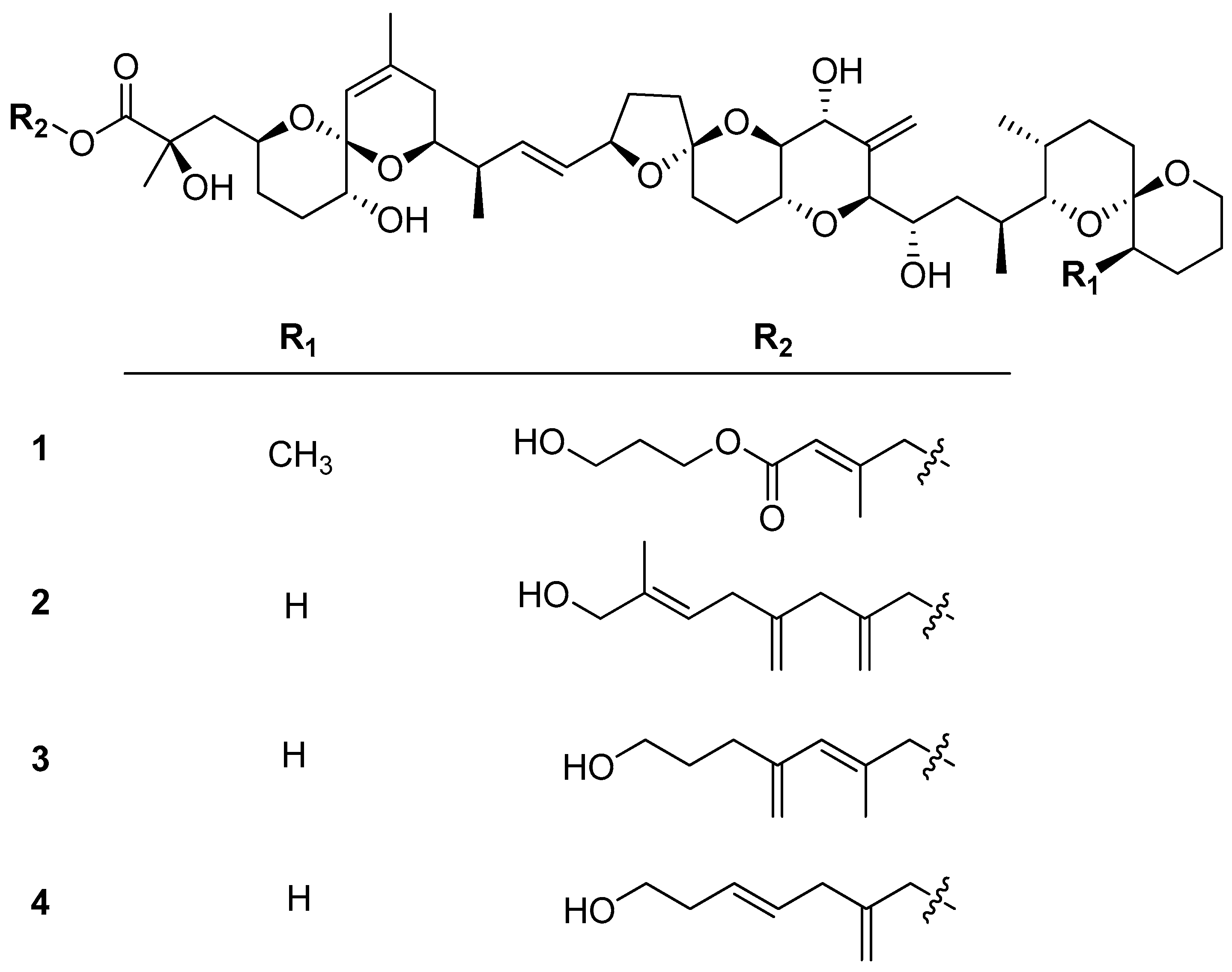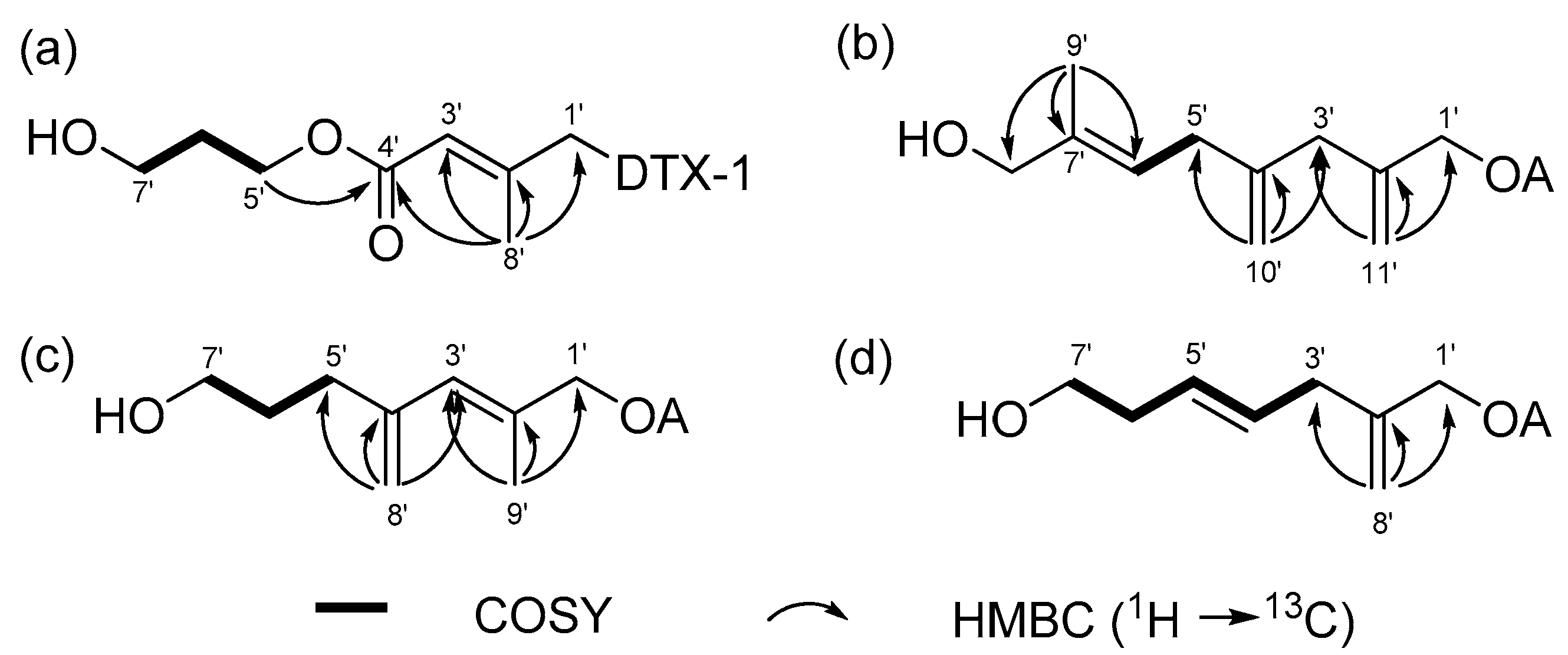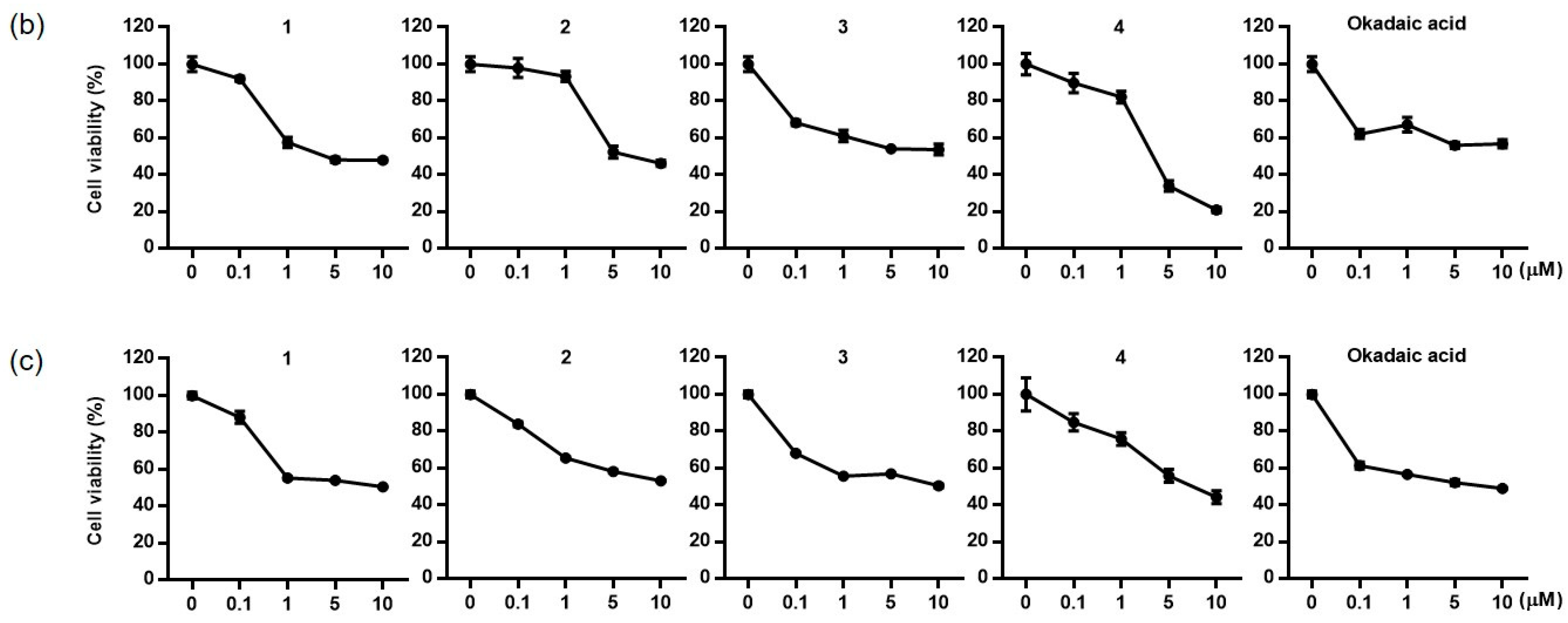Isolation and Structural Identification of New Diol Esters of Okadaic Acid and Dinophysistoxin-1 from the Cultured Prorocentrum lima
Abstract
1. Introduction
2. Results
2.1. Structure Determination of Compounds 1–4
2.2. Cytotoxicity Assessment of Compounds 1–4
3. Discussion
4. Materials and Methods
4.1. Instrumentation
4.2. Cultures of P. lima
4.3. Extraction and Isolation of OA and DTX-1 Derivatives
4.4. DF4+ Probability Calculation for the Diol Moiety of Compounds 1 and 3
4.5. Cell Cultures
4.6. Cytotoxicity Assessment
4.7. Flow Cytometry for Apoptosis Analysis
Supplementary Materials
Author Contributions
Funding
Institutional Review Board Statement
Informed Consent Statement
Data Availability Statement
Conflicts of Interest
References
- Lee, J.S.; Igarashi, T.; Fraga, S.; Dahl, E.; Hovgaard, P.; Yasumoto, T. Determination of diarrhetic shellfish toxins in various dinoflagellate species. J. Appl. Phycol. 1989, 1, 147–152. [Google Scholar] [CrossRef]
- Vale, P.; Veloso, V.; Amorim, A. Toxin composition of a Prorocentrum lima strain isolated from the Portuguese coast. Toxicon 2009, 54, 145–152. [Google Scholar] [CrossRef] [PubMed]
- Yasumoto, T.; Murata, M.; Oshima, Y.; Sano, M.; Matsumoto, G.K.; Calardy, J. Diarrhetic shellfish toxins. Tetrahedron 1985, 41, 1019–1025. [Google Scholar] [CrossRef]
- Cohen, P.; Holmes, C.F.B.; Tsukitani, Y. Okadaic acid: A new probe for the study of cellular regulation. Trend Biochem. Sci. 1990, 15, 98–102. [Google Scholar] [CrossRef]
- Dominguez, H.J.; Paz, B.; Daranas, A.H.; Norte, M.; Franco, J.M.; Fernández, J.J. Dinoflagellate polyether within the yessotoxin, pectenotoxin and okadaic acid toxin groups: Characterization, analysis and human health implication. Toxicon 2010, 56, 191–217. [Google Scholar] [CrossRef] [PubMed]
- Hu, T.; Marr, J.; Defreitas, A.S.W.; Quilliam, M.A.; Walter, J.A.; Wright, J.L.C.; Pleasance, S. New diol esters isolated from cultures of the dinoflagellates Prorocentrum lima and Prorocentrum concavum. J. Nat. Prod. 1992, 55, 1631–1637. [Google Scholar] [CrossRef]
- Suárez-Gómez, B.; Souto, M.L.; Norte, S.M.; Fernández, J.J. Isolation and structural determination of DTX-6, a new okadaic acid derivative. J. Nat. Prod. 2001, 64, 1363–1364. [Google Scholar] [CrossRef] [PubMed]
- Suárez-Gómez, B.; Souto, M.L.; Cruz, P.G.; Fernández, J.J.; Norte, M. New targets in diarrhetic shellfish poisoning control. J. Nat. Prod. 2005, 68, 596–599. [Google Scholar] [CrossRef] [PubMed]
- Norte, M.; Padilla, A.; Fernández, J.; Souto, M.L. Structure determination and biosynthetic origin of two ester derivatives of okadaic acid isolated from Prorocentrum lima. Tetrahedron 1994, 50, 9175–9180. [Google Scholar] [CrossRef]
- Lee, S.; Hwang, B.S.; Kim, H.S.; Yih, W.; Jeong, E.J.; Rho, J.-R. A new diol ester derivative of dinophysistoxin-1 from cultures of Prorocentrum lima collected in South Korea. Bull. Korean Chem. Soc. 2015, 36, 395–398. [Google Scholar] [CrossRef]
- Li, J.; Li, M.; Pan, J.; Liang, J.; Zhou, Y.; Wu, J. Identification of the okadaic acid-based toxin profile of a marine dinoflagellate strain Prorocentrum lima by LC-MS/MS and NMR spectroscopic data. J. Sep. Sci. 2012, 35, 782–789. [Google Scholar] [CrossRef]
- Hu, T.; Curtis, J.M.; Walter, J.A.; McLachlan, J.L.; Wright, J.L.C. Two new water-soluble DSP toxin derivatives from the dinoflagellate Prorocentrum maculosum: Possible storage and excretion products. Tetrahedron Lett. 1995, 36, 9273–9276. [Google Scholar] [CrossRef]
- Hu, T.; Curtis, J.M.; Walter, J.A.; Wright, J.L.C. Identification of DTX-4 a new water-soluble phosphatase inhibitor from the toxic dinoflagellate Prorocentrum lima. J. Chem. Soc. Chem. Commun. 1995, 42, 597–599. [Google Scholar] [CrossRef]
- Cruz, P.C.; Daranas, A.H.; Fernández, J.J.; Souto, M.L.; Norte, M. DTX5c, a new OA sulphate ester derivative from cultures of Prorocentrum belizeanum. Toxicon 2006, 47, 920–924. [Google Scholar] [CrossRef] [PubMed]
- Hu, T.; LeBlanc, P.; Burton, I.W.; Walter, J.A.; McCarron, P.; Melanson, J.E.; Strangman, W.K.; Wright, J.L.C. Sulfated diesters of okadaic acid and DTX-1: Self-protective precursors of diarrhetic shellfish poisoning (DSP) toxins. Harmful Algae 2017, 63, 85–93. [Google Scholar] [CrossRef] [PubMed]
- Moon, S.; Choi, D.H.; Lee, Y.; Rho, J.-R. Three new okadaic acid derivatives isolated from a benthic Dinoflagellate prorocentrum lima. J. Korean Magn. Reson. 2024, 28, 25–31. [Google Scholar]
- Hu, T.; Burton, I.; Curtis, J.M.; Quilliam, M.A.; Walter, J.A.; Windust, A.J.; Wright, J.L.C. Oxidative transformation of a naturally occurring okadaic acid diol ester by the diatom Thalassiosira weissflogii. Tetrahedron Lett. 1999, 40, 3981–3984. [Google Scholar] [CrossRef]
- Fernández, J. J.; Suarez-Gomez, B.; Souto, M. L.; Norte, M. Identification of New Okadaic Acid Derivatives from Laboratory Cultures of Prorocentrum lima. J. Nat. Prod 2003, 66, 1294–1296. [Google Scholar]
- Yasumoto, T.; Murata, M.; Lee, J. S.; Torigoe, K. Mycotoxins and Phycotoxins ’88; Elsevier Science Ltd: Amsterdam, The Netherland, 1989; pp. 373–382. [Google Scholar]
- Miles, C. O.; Wilkins, A.L.; Hawkes, A.D.; Jensen, D.J.; Cooney, J.M.; Larsen, K.; Petersen, D.; Rise, F.; Beuzenberg, V.; MacKenzie, A.L. Isolation and identification of a cis-C8-diol-ester of okadaic acid from Dinophysis acuta in New Zealand. Toxicon 2006, 48, 195–203. [Google Scholar]
- Wu, H.; Chen, J.; Peng, J.; Zhong, Y.; Zheng, G.; Guo, M.; Tan, Z.; Zhai, Y.; Lu, S. Nontarget screening and toxicity evaluation of diol esters of okadaic acid and dinophysistoxins reveal intraspecies difference of Prorocentrum lima. Environ. Sci. Technol. 2020, 54, 12366–12375. [Google Scholar] [CrossRef]
- Lincoln, A.M.; Andrew, I.S.; Paul, M.; Lesley, R. Benthic dinoflagellate toxins in two warm-temperature estuaries: Rangaunu and Parengarenga Harbours, Northland, New Zealand. Harmful Algae 2011, 10, 559–566. [Google Scholar]
- Rodríguez, F.; Riobó, P.; Crespín, G.D.; Daranas, A.H.; de Vera, C.R.; Norte, M.; Fernández, J.J.; Fraga, S. The toxic benthic dinoflagellate Prorocentrum maculosum Faust is a synonym of Prorocentrum hoffmannianum Faust. Harmful Algae 2018, 78, 1–8. [Google Scholar] [CrossRef] [PubMed]
- Zhang, H.; Wu, H.; Zheng, G.; Zhong, Y.; Tan, Z. Variation profile of diarrhetic shellfish toxins and diol esters derivatives of Prorocentrum lima during growth by high-resolution mass spectrometry. Toxicon 2023, 232, 107224. [Google Scholar] [CrossRef] [PubMed]
- Grimblat, N.; Zanardi, M.M.; Sarotti, A.M. Beyond DP4: An improved probability for the stereochemical assignment of isomeric compounds using quantum chemical calculations of NMR shifts. J. Org. Chem. 2015, 80, 12526–12534. [Google Scholar] [CrossRef] [PubMed]




| No | δC, Mult | |||
|---|---|---|---|---|
| 1 | 2 | 3 | 4 | |
| 1’ | 68.6, CH2 | 67.5, CH2 | 71.3, CH2 | 68.0, CH2 |
| 2’ | 154.0, C | 143.0, C | 133.8, C | 144.5, C |
| 3’ | 116.1, CH | 41.9, CH2 | 130.0, CH | 37.7, CH2 |
| 4’ | 167.8, C | 146.7, C | 146.2, C | 130.4, C |
| 5’ | 62.1, CH2 | 34.5, CH2 | 34.6, CH2 | 130.0, C |
| 6’ | 32.8, CH2 | 123.6, CH | 32.3, CH2 | 36.9, CH2 |
| 7’ | 59.4, CH2 | 137.9, C | 62.4, CH2 | 62.8, CH2 |
| 8’ | 16.0, CH3 | 68.7, CH2 | 115.0, C | 113.2, CH2 |
| 9’ | 13.8, CH3 | 16.0, CH3 | ||
| 10’ | 112.9, CH2 | |||
| 11’ | 114.5, CH2 | |||
| No | δH (Mult, J) | |||
|---|---|---|---|---|
| 1 | 2 | 3 | 4 | |
| 1’ | 4.57 (d, 16.9) | 4.54 (d, 13.5) 4.64 (d, 13.5) - 2.88, br s - 2.79 (d, 7.3) 5.48 (t, 7.3) - 3.98, s 1.66, s 4.86, s; 4.91, s 5.04, s; 5.17, s | 4.54 (d, 12.5) | 4.52 (d, 13.4) |
| 4.70 (d, 16.9) | 4.64 (d, 12.5) | 4.62 (d, 13.4) | ||
| 3’ | 5.90 (q, 1.2) | 5.92, br s | 2.79 (d, 5.1) | |
| 4’ | - | - | 5.53, m | |
| 5’ | 4.20 (t, 6.4) | 2.17 (t, 7.1) | 5.53, m | |
| 6’ | 1.87, m | 1.62, m | 2.25 (dt, 6.2, 6.8) | |
| 7’ | 3.64 (t, 6.1) | 3.53 (t, 6.4) | 3.56 (t, 6.8) | |
| 8’ | 2.13, s | 4.87, br s; 5.03, br s | 4.97, br s; 5.05, br s | |
| 9’ | 1.82 (d, 1.2) | |||
| 10’ | ||||
| 11’ | ||||
| μM | |||
|---|---|---|---|
| Neuro2a | HCT116 | HepG2 | |
| 1 | 0.10 | 1.54 | >10 |
| 2 | 0.72 | 5.24 | 5.78 |
| 3 | 0.07 | 0.17 | 0.17 |
| 4 | 4.54 | 4.30 | 5.33 |
| Okadaic acid | 0.07 | 0.14 | 0.14 |
Disclaimer/Publisher’s Note: The statements, opinions and data contained in all publications are solely those of the individual author(s) and contributor(s) and not of MDPI and/or the editor(s). MDPI and/or the editor(s) disclaim responsibility for any injury to people or property resulting from any ideas, methods, instructions or products referred to in the content. |
© 2025 by the authors. Licensee MDPI, Basel, Switzerland. This article is an open access article distributed under the terms and conditions of the Creative Commons Attribution (CC BY) license (https://creativecommons.org/licenses/by/4.0/).
Share and Cite
Ji, Y.K.; Moon, S.; Lee, S.; Kim, Y.N.; Jeong, E.J.; Rho, J.-R. Isolation and Structural Identification of New Diol Esters of Okadaic Acid and Dinophysistoxin-1 from the Cultured Prorocentrum lima. Toxins 2025, 17, 28. https://doi.org/10.3390/toxins17010028
Ji YK, Moon S, Lee S, Kim YN, Jeong EJ, Rho J-R. Isolation and Structural Identification of New Diol Esters of Okadaic Acid and Dinophysistoxin-1 from the Cultured Prorocentrum lima. Toxins. 2025; 17(1):28. https://doi.org/10.3390/toxins17010028
Chicago/Turabian StyleJi, Yeong Kwang, Semin Moon, Sangbum Lee, Yun Na Kim, Eun Ju Jeong, and Jung-Rae Rho. 2025. "Isolation and Structural Identification of New Diol Esters of Okadaic Acid and Dinophysistoxin-1 from the Cultured Prorocentrum lima" Toxins 17, no. 1: 28. https://doi.org/10.3390/toxins17010028
APA StyleJi, Y. K., Moon, S., Lee, S., Kim, Y. N., Jeong, E. J., & Rho, J.-R. (2025). Isolation and Structural Identification of New Diol Esters of Okadaic Acid and Dinophysistoxin-1 from the Cultured Prorocentrum lima. Toxins, 17(1), 28. https://doi.org/10.3390/toxins17010028






